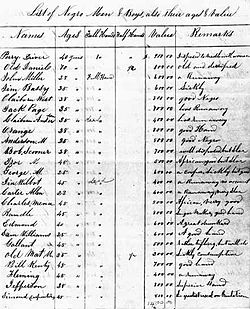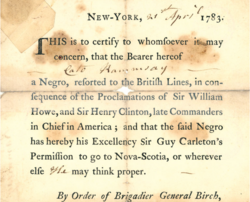
Known as Evacuation Day 1783[1], November 25, 1783, is when the last of the British militia and those loyal to the British Empire[2] were ordered to evacuate New York City at the end of the American Revolutionary War[3]. Researching African descendant ancestors who fought in the Revolutionary War or who lived in Canada in the 1700s isn’t complete without examining The Book of Negroes[4][5]. The manuscript ledger, created at the end of the Revolutionary War, documents the evacuation of 3,000 enslaved, indentured and freedmen along with British soldiers and loyalists to Nova Scotia, Canada, then, a British Territory seeking refuge following the British surrender.
Sir Guy Carleton[6][7], First Baron of Dorchester, and Commander-in-Chief of British forces from 1782 until the end of the American Revolution wanted to honor the agreement Britain made with the enslaved which was to set them free if they fought on the side of the British. Despite the agreement, American Patriots were pushing for immediate repossession of their enslaved. Although Sir Carleton and General George Washington[8] met to discuss the return of the enslaved to their former owners, Sir Carleton was torn by the notion and allowed Black Loyalists[9][10] to board ships to be evacuated to safety, thus honoring their right to freedom according to British policy.
Black Loyalists were largely evacuated from the Port of New York to Nova Scotia, Canada[11], then, British Territory. The ships used had a committee of ship inspectors who documented the arrival of each passenger. This documentation, called “The Book of Negroes"[12] is the single most important document relating to the immigration of Negroes following the Revolutionary War. The majority of the passengers went to Nova Scotia, Canada, while some went to other places. The value of the vast information captured in this ledger lies in the details. Varying from case to case the document is a treasure trove for the researcher. These inspection rolls largely range from April through November 1783. They include such information as name; whether free, refugee or indentured; identity of some family members; former enslaver; how they were separated from their enslaver; some health information; some military service, if applicable; along with vessel boarded; Commander; ship’s name and destination.
Research your ancestors on MyHeritage
Two VersionsTwo Versions
The "Book of Negroes" exists in two original versions, created separately but at the same time by the British and the Americans as they registered those that boarded creating a permanent record. Handwritten, some entries create a challenge for the reader. Both have columns to record the name of the vessel, commander, name of Negro, age and description, claimant’s name and place of residency plus a section for notes.
Vessels, Commanders and PassengersVessels, Commanders and Passengers
The ledger entries offer otherwise unknown information about passengers and their lives. Not everyone recorded in the ledger would actually sail. Sometimes claimants stepped forward making assertions of ownership, whether true or fabricated, resulting in Negroes being removed from vessels.
ClaimantsClaimants
The ledger named a person, whether Patriot, Loyalist or other, who laid claim to particular person. As an example, an entry for the vessel Mars identifies a thirty-year-old Sarah and her infant, described as a short wench, claimed by Jasper Buckel of St. Johns to have bought her of John Tabor Kempe and produced a Bill of Sale.
Military ServiceMilitary Service
Some serving in the military took their enslaved with them or even substituted their service for their own. This likely accounts for some of the military presence onboard some vessels. Men with military status as shown by their regiment, government department or ship were in possession of a Negro. The Lady’s Adventure carried several Negroes who were attached to the Drummer Regiment. Thirty-year-old Samuel Banmord(sp) and twenty-one-year-old David Devonshore are just two examples.
Several Negro passengers were in the possession of the Provost Master and some onboard were listed as in the possession of sailors.
Health and OriginsHealth and Origins
The ledger generally specifies the residence of the master, not the place of origin of the Negro, since clarification is not available, they may or may not be one in the same. An entry for the vessel Aurora offers information related to health and origins for seventy-year-old Daniel Boviber(sp) described as “worn out”. An entry for thirty-nine-year-old John Vans describes him as healthy but blind in his right eye.
Also on the vessel Aurora is an entry for a twenty-four-year-old mulatto from Madagascar named Elizabeth Black.
Born FreeBorn Free
Forty-one-year-old Tertullis, an entry on the ship Betsey under the Commander Wm. Galili(sp), was described as stout fellow, free born Southhole.
Nineteen-year-old Joe Grant was recorded upon boarding the Nautilus, under the command of Kildaire Richardson bound for Albaco, in the Bahamas, and free born in Bristol, Barbados.
Identifying Enslaver or IndenturedIdentifying Enslaver or Indentured

An entry for the vessel Ariel, bound for St Johns, identifies twenty-two-year-old Susanna Jarvis, a stout and healthy negress, currently in the possession of John Joseph Browne. The notes state that she was indentured to T. T. Browne, says she was made free about 9 years ago, when Mr. Blowfield died.
Another port of arrival is Annapolis Royal. The vessel William and Mary commanded by Moses Brewer shows an entry for a likely family, thirty-year-old Mellia Merchant, described as a stout wench, six-year-old Amelia Merchant and four-year-old Ben Merchant. The notes say that each is the former property of John Merchant near South Carolina and that they left at the siege of Chas Town. The notes also list Amelia and Ben as children of Mellia.
On the vessel Spring, bound for St. Johns is recorded thirty-five-year-old George Black, twenty-five-year-old Ann Black and children seven-year-old Reuben and five-year-old Sukey. Though no descriptions were recorded of the four listed, they are likely a family. Further scrutiny of the document under the notes, says that they were freed by former enslaver Lawrence Hartshorne as certified and are currently in the possession of Col. Isaac Allen.
Surprisingly there were passengers with claimants who were listed as residents of Germany bound for Spithead and Germany onboard some of the vessels.
Finalizing the LedgerFinalizing the Ledger
Both versions kept a tally of men, women and children. At the end of each version is a summary of the ledger as follows:
“Recapituation of the number of Negroes who have availed themselves of the said Commander in Chiefs Declaration by coming in with the British Lines in North America which numbers distinguishing men, women & children have been inspected by the Commissioners appointed by his faculty Sir Guy Carleton, R. B. Commissioner-in-Chief, for that purpose, onboard the several vessels in which they were embarked, previous to their time of sailing from the Port of New York in North America between the 23rd April and the 30th Novem’r, 1783 both days inclusive. Men, women, children, total, 3000.
See alsoSee also
Explore more about The Book of NegroesExplore more about The Book of Negroes
- Garrison, William Lloyd. The Loyalty and Devotion of Colored Americans in the Revolution and War of 1812. Boston: R.F. Wallcut, 1861.
- Inspection Roll of Negroes Book No. 1, Series: Miscellaneous Papers of the Continental Congress, 1774 - 1789, Record Group 360: Records of the Continental and Confederation Congresses and the Constitutional Convention, 1765 - 1821, National Archives, Washington, D.C.
- Inspection Roll of Negroes Book No. 2, Series: Miscellaneous Papers of the Continental Congress, 1774 - 1789, Record Group 360: Records of the Continental and Confederation Congresses and the Constitutional Convention, 1765 - 1821, National Archives, Washington, D.C.
- Hodges, Graham Russell Gao, and Alan Edward Brown, eds. The Book of Negroes: African Americans in Exile after the American Revolution. 1st ed. Fordham University Press, 2021.
- What Was the Book of Negroes?. The Journal of Blacks in Higher Education, no. 63 (2009): 28–28.
- Boston King, “Memoirs of the Life of Boston King, A Black Preacher,” The Methodist Magazine 21 (March 1798), 106–10, and 21 (April 1798).
- Bonikowsky, Laura Neilson. “The Arrival of Black Loyalists in Nova Scotia.” The Canadian Encyclopedia. Published October 18, 2013. Updated by Eli Yarhi and Andrew McIntosh, December 5, 2019.
- Oyeniran, Channon. "Black Loyalists in British North America." The Canadian Encyclopedia. Published online March 25, 2019. Last edited February 3, 2021.
- The Negro and the American Revolution (Chapel Hill: University of North Carolina Press, 1961).
- Simon Schama, Rough Crossings: Britain, the Slaves, and the American Revolution (New York: HarperCollins, 2006).
- Evacuation Day & NYC. History 101
- Nova Scotia Archives - African Nova Scotians in the Age of Slavery and Abolition
- New York Public Library Archive & Manuscripts. Dorchester, Guy Carleton, Baron.
- Black Loyalist Directory, 1783-1788 Online database. AmericanAncestors.org New England Historic Genealogical Society, 2023. Original book: The Book of Negroes: African Americans in Exile After the American Revolution, Fordham University Press: New York, 2021.
- Christopher Leslie Brown and Philip D. Morgan, eds., Arming Slaves: From Classical Times to the Modern Age (University Press: New Haven, 2006).
- Library and Archives Canada. Black Loyalist Refugees, 1782-1807- Port Roseway Associates - Library and Archives Canada (bac-lac.gc.ca)
- Wythepedia. W & M Law Library. Book of Negroes - Wythepedia: The George Wythe Encyclopedia (wm.edu)
- Global Genealogy
References
- ↑ "Evacuation day" and Washington's triumphal entry in New York City, Nov. 25th, 1783. The Maryland State House
- ↑ British Empire | History, Countries, Map, Size, & Facts. Britannica
- ↑ Overview of the American Revolutionary War | American Battlefield Trust (battlefields.org)
- ↑ https://lawlibrary.wm.edu/wythepedia/index.php/Book_of_Negroes
- ↑ https://rediscovering-black-history.blogs.archives.gov/2015/02/05/rotw-the-book-of-negroes/
- ↑ Sir Guy Carleton | George Washington's Mount Vernon
- ↑ https://www.biographi.ca/en/bio/carleton_guy_5E.html
- ↑ George Washington: Facts, Revolution & Presidency | HISTORY
- ↑ Black Loyalists: Our History, Our People (gmu.edu)
- ↑ CDC: Black Loyalists
- ↑ Canada in the 18th Century, colonized and torn into two (canadaya.ca)
- ↑ https://rediscovering-black-history.blogs.archives.gov/2015/02/05/rotw-the-book-of-negroes/
- ↑ https://www.biographi.ca/en/bio/carleton_guy_5E.html
- ↑ Carleton Papers – Book of Negroes, 1783 - Library and Archives Canada (bac-lac.gc.ca)
- ↑ FamilySearch Catalog: The Black Loyalist directory : African Americans in exile after the American Revolution — FamilySearch.org

